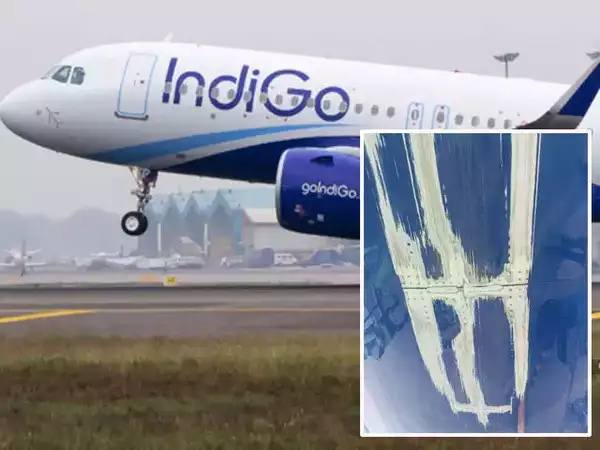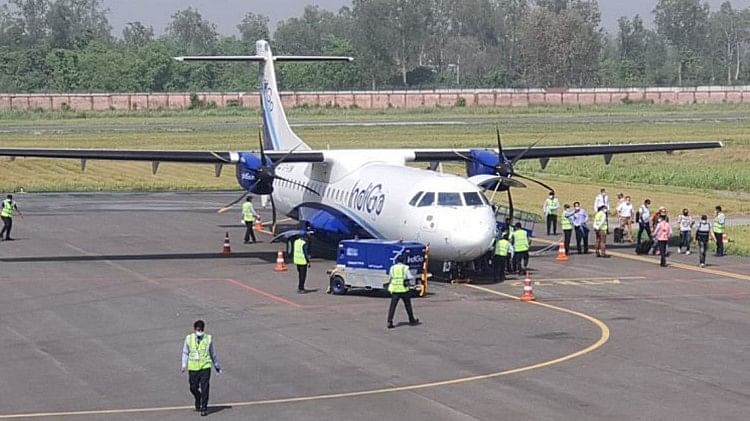IndiGo’s Reckless Approach Has Given Way To A Disturbing Trend of Tailstrikes, Endangering Passenger And Crew Well-Being; Why Is Indigo & DGCA Caught Napping?
One of India's largest airlines, Indigo, is facing scrutiny and concern due to its repeated disregard for safety protocols, thus, putting the safety of both passengers and crew members at risk. Recent incidents of tail strikes put broader issues within the airline into the spotlight - Pilot Fatigue, Saving On Fuel etc. - where crucial safety measures are being neglected. So what is the reason behind IndiGo's failure to follow proper protocols? The consequences of the same are alarming, and there is an urgent need for corrective action. Also, why is DGCA quiet on this issue?

In recent times, IndiGo, one of India’s major airlines, has come under scrutiny due to its repeated disregard for safety protocols, putting the safety of passengers and crew members at risk.
There have been reports of multiple incidents of tailstrikes (where the aircraft’s aft fuselage hits the runway during take-off or landing) that have raised concerns about the airline’s commitment to safety. These incidents point to an alarming sign that IndiGo is not following the right protocols, thus, jeopardizing the well-being of those onboard.
What Are Tailstrikes?
Tailstrikes, although not uncommon, have been relatively rare in recent years in India. However, the same is not the case anymore; over the past year, IndiGo has reported four tailstrikes, but what is even more alarming is the fact that an investigation on the issue has revealed that there have been as many as eight such incidents!
IndiGo’s Neglected Safety Protocols is a wake-up call for potential disaster.
Tailstrikes, although often downplayed by airlines, pose a significant risk to aircraft safety. These incidents occur when the aft fuselage of a plane hits the runway during take-off or landing; this can potentially cause severe damage to the airframe and pressure bulkhead that is responsible for maintaining cabin pressure at high altitudes.

Why Are Tailstrikes Dangerous?
History has shown that tailstrikes can have fatal consequences, as demonstrated by past accidents.
In August 1985, Japan Air Lines Flight 123 experienced a structural failure and decompression shortly after take-off, resulting in a devastating crash that claimed the lives of 505 passengers and all 15 crew members. Subsequent investigations into the crash revealed that improper repair work following a tailstrike seven years earlier had contributed to the failure.
Similarly, in 2002, China Airlines Flight 611 disintegrated mid-air and crashed into the Taiwan Strait, killing all 225 people on board. The final report attributed poor performance as the primary cause, with the aircraft having previously scraped its tail during a landing two decades prior.
Indigo’s Tailstrikes Must Be Taken Into Account
As India’s leading airline, Indigo carries almost two-thirds of the country’s air passengers. As demonstrated by the above two incidents, given the potential for disaster, it is crucial to address the repeated tailstrikes witnessed by IndiGo.
Hence, the troubling question’s are –
Why is IndiGo experiencing such incidents that could lead to catastrophic accidents in the future?
And why is Indigo not doing anything about it?
Equally important, what actions is the aviation regulator taking to address the issue?

DGCA Is Napping?
Interestingly, these incidents largely went unnoticed by the Directorate General of Civil Aviation (DGCA) until a recent audit into IndiGo’s safety practices. The audit findings exposed serious concerns, including deviations from Airbus’s instructions and pilots feeling pressured by the airline to save fuel.
Only then did the regulator issue a show-cause notice to IndiGo, questioning why the airline should not face consequences for endangering air safety.
What Did The Audit Reveal?
1. The DGCA’s findings revealed that IndiGo had programmed its systems to generate immediate reports in the event of heavy landings. This practice compelled pilots to prioritize smooth landings, leading to techniques that increased the likelihood of tailstrikes.
2. Moreover, the airline discouraged pilots from making hard landings, despite evidence from the Mangaluru crash in 2010 that hard landings could prevent accidents.
3. The audit uncovered that IndiGo pilots were instructed to perform a specific landing technique called Config #3, which reduces drag and saves fuel compared to Config #4.
However, in the most recent tailstrike incident in June, it was discovered that the IndiGo pilot had made an error by landing on autopilot mode with Config #4 at Config #3 speed, resulting in a tailstrike.
4. Furthermore, data indicates that tailstrikes occurred not only with IndiGo’s Airbus A321neo planes but also with its regional turboprop ATRs. Unfortunately, both the regulator and the airline took little action to address this issue.
5. Discrepancies in the reported number of tailstrikes add to the concern, with the airline reporting four incidents, the DGCA reporting six, and internal data suggesting as many as eight tailstrikes.

Unaddressed Issues at the Airline
The recent tailstrike incidents at IndiGo have shed light on deeper problems within the airline.
Former joint director general of DGCA, AK Chopra, highlights how airlines often downplay tailstrikes to avoid external scrutiny. The accumulation of such incidents can have serious consequences and potentially lead to major accidents.
Chopra recalls a conversation with the powerful bureaucrat and Air India chairman, V Thulasidas after an Air India Express plane overshot a runway during his tenure. Thulasidas attempted to minimize the incident, but Chopra emphasized the escalating risks associated with such incidents, suggesting that ignoring the issue could result in more severe accidents.
AK Chopra, recalls that during his tenure from 2005 to 2010, there were no reported tailstrikes. The increasing occurrence of these incidents suggests mishandling in the operations department and a lack of proper pilot training; he further emphasizes the need to assess pilot instructors as well.

Blaming The Pilot Or Indigo’s Inefficiencies!
Prior to the audit, DGCA officials visited IndiGo’s headquarters but concluded that each tailstrike was of a “different nature,” implying that the blame should rest solely with the pilot rather than the airline.
However, DGCA Chief Vikram Dev Dutt remained unconvinced and ordered a separate audit, recognizing a systemic problem within the airline.
Indigo V/S Vistara
While it is true that tailstrikes are more common with Airbus A321neo planes due to their longer fuselage, this argument falls flat when comparing IndiGo to its rival, Vistara, which operates the same aircraft but has not experienced tailstrikes recently.
This suggests that the issue extends beyond the aircraft design and may be related to inconsistent landing policies. Vistara’s pilots have been instructed to follow a consistent landing policy using Config #4, even though it consumes more fuel.
The use of Config #3 in IndiGo’s landing technique adds complexity and increases the risk of incidents.
Moreover, the cost-saving benefits of fuel efficiency measures are negated by the expenses required for aircraft repairs following a tailstrike.
After a tailstrike, the entire fuselage, not just the tail, must be examined. Repair costs can reach half a million dollars or more, with the grounding of the aircraft lasting three to four months. In some cases, Airbus engineers need to be called in to carry out the repairs.
After a tailstrike incident around New Year’s Eve in Kolkata, Airbus had to be summoned to fix the aircraft. However, the time taken by the European manufacturer to visit can be lengthy, resulting in planes being wrapped and parked for extended periods. In the cases of tailstrikes in Nagpur and Delhi, IndiGo conducted temporary repairs and operated the planes as per regulations. However, tailstrikes are not the only cause for concern within the airline.

Pilots To Blame Or Indigo?
Delving deeper, one can identify additional pressing issues at IndiGo.
- Fatigue Factors Fatigue is a significant concern among IndiGo’s pilots, with nearly a dozen emails being sent daily to the airline, highlighting issues related to fatigue and its effects.
- Pilots have raised concerns about increasing night flying, dynamic rosters, consecutive nights of flying, long waits at crowded airports and lounges, terminal changes, and, most critically, breaching the Window of Circadian Low (WOCL).
The primary WOCL occurs during the night, typically from 2 am to 6 am when physiological sleepiness peaks and performance capabilities are at their lowest. This was identified as a contributing factor in the Air India Express crash, as the flight landed in Mangaluru at 6 am.
- Pilots express their concerns but often feel unheard by the operations department. Pilots describe challenging duty patterns that lead to fatigue and compromise safety. Despite raising these concerns, pilots are informed that these duty patterns are legal according to DGCA guidelines.
- When pilots express their fatigue and inability to operate a flight, it counts as sick leave. However, half a day of sick leave is deducted if they complain of fatigue during their work schedule—many question why experienced pilots, including management pilots, are not sharing the increasing flight burden.
Half Baked Truths
IndiGo acknowledges some of the lapses mentioned above and admits to the occurrence of tailstrikes. The airline states that four incidents have occurred between January and June 2023, with three aircraft repaired and one currently under repair.
IndiGo confirms receiving a show-cause notice from DGCA. Interestingly, the airline asserts that all four incidents are unrelated, potentially refuting the initial assessment by the first team of DGCA officials.
The Last Bit, The multiple tailstrikes faced by IndiGo serve as a warning signal, indicating deeper problems within the airline’s operations and safety practices. The incidents, the airline’s response, and the regulator’s oversight necessitate immediate action to prevent potential disasters.
It is evident that IndiGo faces multifaceted challenges that must be addressed promptly. Neglecting these issues could compromise the safety of passengers and crew members, underscoring the need for comprehensive actions to rectify the situation.
IndiGo must prioritize safety, address the root causes of tailstrikes, and improve transparency to regain passengers’ trust. Only through proactive measures and a genuine commitment to safety can IndiGo avert the looming risks and ensure the well-being of its passengers and crew.




